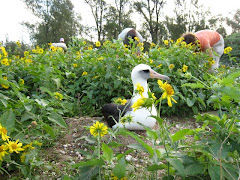


Midway: A Place of Healing
By:George Hanks
Today Tracy Ammerman with the US Fish and Wildlife Service led us on a tour of the historical buildings on Sand Island from World War II. Many people think of WWII in the Pacific only as a series of battles and dates that they had to to remember in grade school. Since none of the major battles were fought on the US mainland we rarely, if ever, have daily contact with relics from this war. Things are very different here on Midway. Everywhere you turn you see places, buildings, and relics connected to the two battles of Midway, on December 7, 1941 and six months later on June 4-6, 1942. During our tour we learned the personal stories of the young men who lived, fought and often died here. We saw the mess hall where they ate, the chapel where they prayed, and the beaches where they played before the start of the war. Sitting inside now empty pill boxes overlooking the lagoon where sentries once stood waiting for the coming Japanese invasion and inside 5 inch gun emplacments where the shells from enemy ships once rained down, you are instantly transported back to the tense early months of the war. You can sense the raw emotions of the young seventeen year old sailor, armed with a surplus rifle from World War I, after being told by his superior officer to do what you can, because if the Japanese take Midway, they will take Hawaii; to do what you can because if the Japanese take Hawaii, the coast of California will be defenseless; to do what you can, because the Japanese will not take you prisoner. Young men facing the very real possibility that they would die alone, in unmarked graves, in a far away place never to see their families again. Everywhere you turn you sense the power of place.
I did not expect the feeling of peace that I also experienced during the tour at each site.The sites are still. Despite the ravages of war everywhere you look the island is slowly returning to the way it was long before we arrived. On runways where fighters once turned into the wind and flew into into the sky to defend Midway, there are now thousands of albatross chicks turned into the wind flapping their wings in unison and learning how to fly to far off seas. On beaches where Seabees dug entrenchments, there are now little sand crabs digging out their burrow homes. On the shores were once pickets stood to stop Japanese troops, a mother monk seal and her pup roll around in the surf. In pillboxes where young marines once stood guard, fairy terns and tropic birds have now made their homes. In the skies above the ironwood trees where planes off to battle in formation, fairy terns dart and swoop in pairs and then soar up hundreds of feet into the sky on the incoming wind from the lagoon. Looking at what each site has now become you get the sense that the island is healing itself from the physical trauma it has suffered. It is shaking off the effects of war like unwanted dust and once again returning the island to the home that it once was for all of its true inhabitants. At the end of the tour, I walked past a Japanese war memorial near the Clipper House with offerings from both Japanese and American veterans who attended the 68th anniversary ceremony of the Battle of Midway just a few short weeks ago. During the tour Tracy told us that you cannot heal unless you know your history. After coming to Midway, I now know what she means.





































